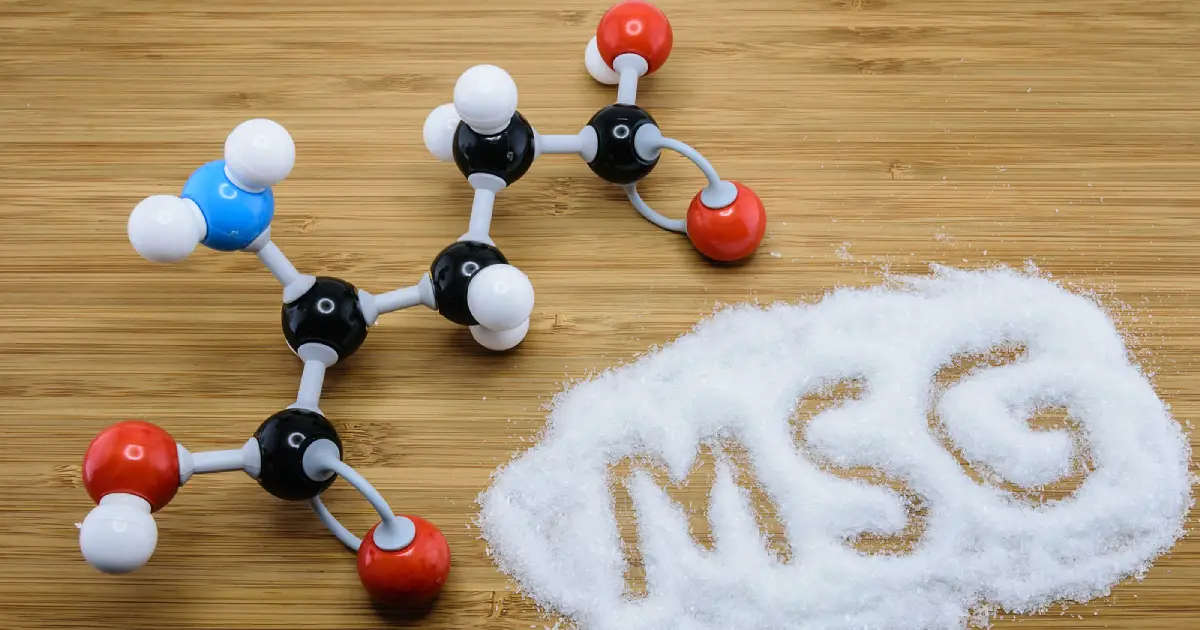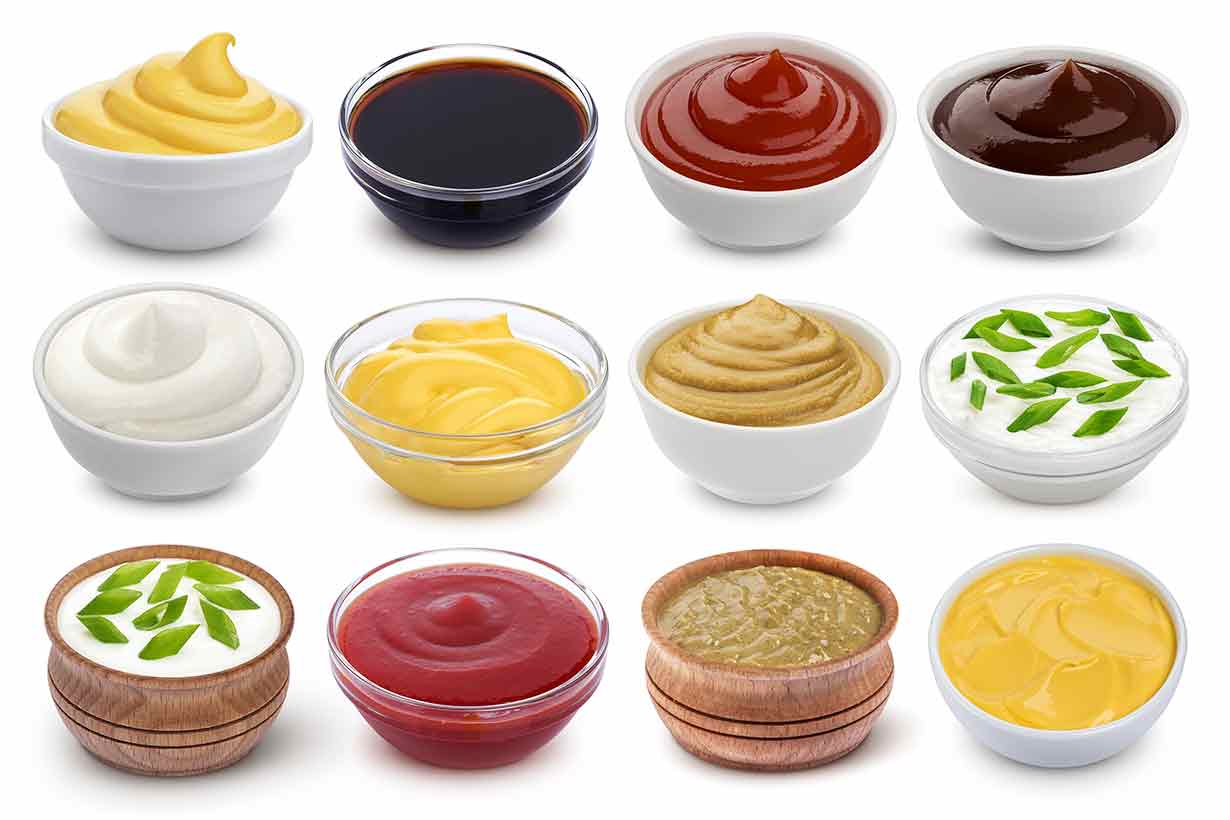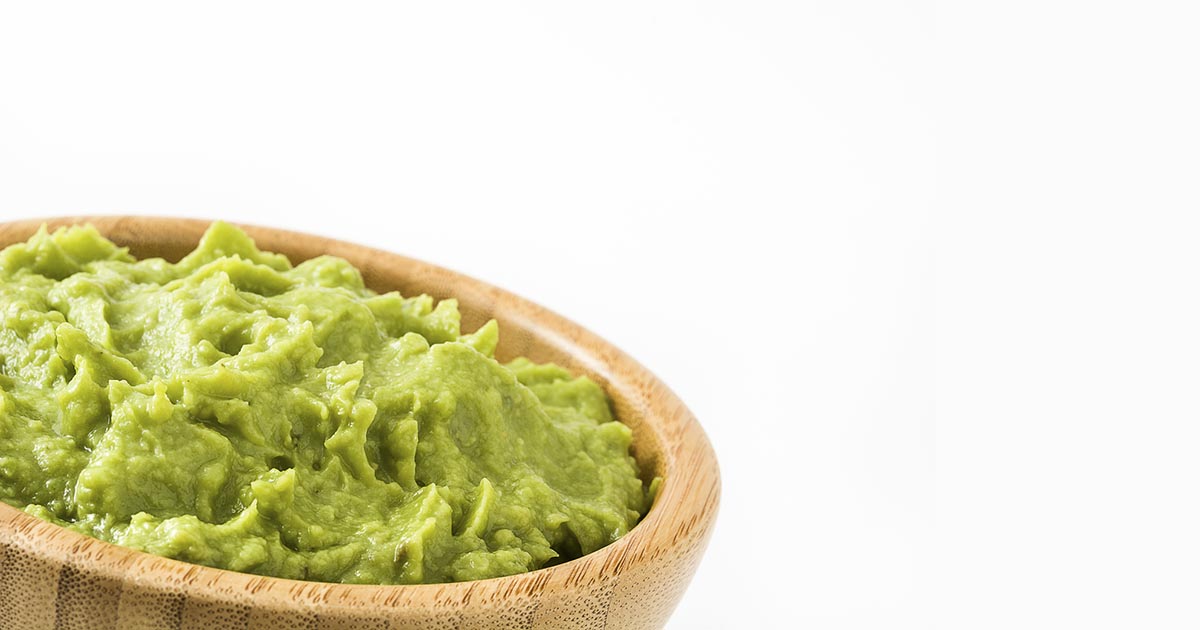Monosodium glutamate, also known as MSG, is a flavor enhancer found in a wide range of processed foods. It can also be used as a condiment or to provide a fuller flavor to recipes.
But is MSG a safe option? We often see this topic in the media, so let’s take a look at what the actual science says.
In this article, we will discuss exactly what MSG is, its potential benefits and downsides, and what the latest scientific findings say. We will also examine the positions of major public health bodies.
MSG In a Nutshell
- What is it: MSG is simply one unit of sodium bonded to one unit of glutamate—an amino acid.
- Safety profile: The U.S. FDA has given MSG ‘Generally Recognized as Safe’ (GRAS) status, and the WHO/FAO also consider it safe.
- Concerns: While scientific evidence hasn’t found adverse effects from typical dietary consumption in humans, the European Food Safety Authority recommend conservative daily limits.
What Is MSG?

What you might not know is that MSG is made from two simple ingredients: sodium and glutamate.
As a type of salt, MSG is the sodium salt of glutamic acid, an amino acid that has desirable flavor characteristics.
The use of MSG amplifies the flavor and palatability of food. While it does not have an enjoyable taste eaten on its own, it enhances the natural flavors present in food.
While MSG is a salt, it is quite different from sodium chloride (table salt) in flavor and characteristics. Perhaps most notably, regular table salt contains approximately triple the sodium content of MSG.
MSG is made through a relatively simple process of fermenting either starch or sugar.
What Does Monosodium Glutamate Mean?
The name monosodium glutamate shows the chemical structure of MSG. Mono means one, sodium is an element found in MSG, and glutamate is a compound in MSG.
Therefore, the term ‘monosodium glutamate’ refers to one unit of sodium bonded to one unit of glutamate.
Glutamate is an amino acid with a “umami” taste that the human tongue has specific taste receptors for.
MSG vs. Free Glutamate
The food industry highly values MSG. We can find MSG or free glutamate—which has an identical “umami” flavor—in a wide range of processed foods.
‘Free glutamate’ refers to the amino acid glutamate when it is no longer part of a whole protein structure. It is present in many foods, including aged cheese and mushrooms, and it’s also in flavoring additives like yeast extract. Free glutamate has the same taste and effect in the body as MSG.
You may find MSG or free glutamate on nutrition labels under several different names, including but not limited to:
- E621 (the European E number for MSG)
- Flavoring
- Flavor enhancer
- Glutamic acid
- Hydrolyzed protein
- Monosodium glutamate
- Monosodium salt
- Natural flavor
- Textured protein
- Yeast extract
Note: While MSG requires labeling as monosodium glutamate or E621, free glutamate may appear as any of these ingredient names.
Much historic concern over MSG has been due to speculation that the free glutamate it contains may cross the blood-brain barrier, leading to elevated glutamate levels in the brain, potentially causing neurological issues.
However, scientific research has shown that glutamate—whether from whole food sources of MSG—is metabolized in the gut. Notably, it does not cross the blood-brain barrier, and free glutamate levels in the brain do not increase.
What Foods Contain MSG?
While this is not an exhaustive list, MSG is a common ingredient in the following foods:
- Condiments such as barbecue sauce, ketchup, mayonnaise, and soy sauce may sometimes contain MSG.
- Cooking sauces: Cooking sauces for foods like pasta and rice often contain MSG.
- Food seasoning blends
- Instant noodles: The flavoring blend in instant noodles frequently contains MSG.
- Pre-packaged meals: It is common for prepared meals or “TV dinners” to contain MSG.
- Soups and stews: Packaged soups and stews often have added MSG among their ingredients.
- Takeout food: Chinese, Indian, and Western-style takeout fast food often contains MSG.
If anyone has a medical reason to avoid MSG, it is important to check nutrition labels carefully.
Potential Benefits
MSG has some potential benefits when included in the diet, which somewhat depend on its interaction with other foods and table salt use.
MSG May Help Reduce Sodium Intake
Since MSG contains only around one-third of the sodium content of table salt, switching from the use of table salt to MSG in cooking may help to significantly lower sodium intake.
This is an important factor because most people consume too much sodium—with Americans consuming 3,300 mg on average rather than the recommended daily value of 2,300 mg.
High sodium intake elevates blood pressure, which is a significant risk factor for cardiovascular disease over the long-term.
Several scientific papers have been published on the topic of salt reduction using MSG. Findings from these studies have included:
- MSG may help to improve the taste of less flavorful foods with lower salt levels.
- MSG amounts up to 0.5g per 100g of food is an accepted amount that can help to lower the use of table salt in food.
- Studies involving taste panellists have demonstrated that adding MSG to low-sodium prepared foods did not negatively impact the acceptability (enjoyment) of the food.
In short, the addition of MSG can reduce a food’s salt content, which may help people lower their sodium intake.
MSG May Encourage Greater Consumption of Healthy Foods
One important point on diet and nutrition: some foods can be incredibly nutrient-rich, but they’re only beneficial if people will actually eat them.
In this regard, people are more likely to regularly consume foods that they enjoy. According to the findings of a 2025 randomized controlled trial involving 60 participants, this is where MSG may potentially have benefits:
- There was a trend for consumers preferring the MSG-seasoned vegetables.
- Compared to the control group consuming vegetables with only table salt, the intervention groups consuming a mix of MSG and table salt either maintained or slightly increased their vegetable intake.
However, there were no statistically significant differences in total vegetable intake between both groups. The sample size was also small, with only 60 people involved in the trial, thereby necessitating further research.
That said, the palatability and overall enjoyment of food is widely recognized as being key for maintaining a sustainable, healthy dietary pattern.
Is MSG Safe?
As with many food additives, there has been speculation about the health effects of MSG in the media for decades.
The U.S. Food and Drug Administration (FDA) notes that they have received reports of headache symptoms following MSG consumption. However, they have never been able to confirm that MSG was responsible for these symptoms.
Fortunately, a large body of research on the effects of MSG is available.
Research on MSG’s Safety: Systematic Reviews
- A 2023 systematic review found that high-dose treatment with MSG in mice led to neuronal symptoms associated with Alzheimer’s disease. However, some of the MSG doses used were hundreds of times greater than typical human dietary exposure. Given this limitation and the fact it is preclinical research in mice, this review cannot comment on how typical doses of MSG affect human health.
- A 2016 systematic review of 8 human studies investigated whether MSG causes headaches. The review found inconsistent results and could not confirm a causal relationship.
- A 2012 systematic review of randomized controlled trials assessed the impact of MSG on asthma. However, the review included only two trials and found no evidence to recommend MSG avoidance in adults with asthma.
Position of Major Public Health Organizations
Several major public health organizations have extensively investigated the safety of MSG, including:
- The FDA
- Joint FAO/WHO Expert Committee on Food Additives (JEFCA)
- The European Food Safety Authority (EFSA)
FDA Position
- The FDA has given adding MSG to foods ‘generally recognized as safe’ (GRAS) status.
- However, the FDA did note that some individuals may have sensitivities to MSG when consumed at doses at or above 3 grams without food.
JEFCA
- JEFCA have set a “Not Specified” classification for the Acceptable Daily Intake (ADI) of MSG. This means that they do not view it as a health concern for the general public.
- This classification was due to metabolization of the glutamate in MSG being identical to how the body metabolizes glutamate in foods like Parmesan cheese or tomatoes. The body treats them no differently, with neither causing a large rise in blood glutamate levels.
EFSA
- In 2017, the EFSA set a more cautious ADI of 30 mg/kg body weight of added (free) glutamate daily.
- This ADI is based on an analysis of findings from animal studies, based on the most conservative doses where no effects were seen. The EFSA then applied a “default uncertainty factor of 100,” effectively making the ADI 100 times lower than the No Observed Adverse Effect Level (NOAEL) seen in animal studies.
- 30 mg/kg of body weight is equivalent to around 2 grams per day for 60–70 kg adults.
- The EFSA report also acknowledged that free glutamate like MSG is digested identically to glutamate within whole, protein-rich foods.
- The EFSA also noted that some population groups, including children, may have an added glutamate intake exceeding the ADI.
Overall, the FDA and JEFCA do not treat MSG as a concern for public health. While the EFSA has set an ADI of 30 mg/kg body weight, this is an ultra-cautious, conservative number.
MSG Sensitivity
Can you be allergic to MSG? Based on the existing research, it is widely thought that MSG does not cause allergic reactions.
However, clinical trials have shown that large doses of MSG consumed without food may potentially cause temporary symptoms such as weakness, tingling, flushing, and headaches. These symptoms were seen in individuals claiming to have reactions from MSG ingestion, which has sometimes been dubbed “MSG intolerance.”
These findings confirm the FDA’s position that some individuals may have sensitivities to high doses (>3g) of MSG consumed without food.
How To Use
If you choose to use MSG, you may be wondering how much you should use in cooking.
However, this really depends on the context—here are some factors to consider:
- For flavoring food: The Glutamate Association advise that “approximately one-half teaspoon” of MSG is sufficient for a pound (454g) of meat or 4–6 servings of cooked dishes, such as casseroles. Half a teaspoon is approximately 2 grams.
- Salt substitution: Studies have found that replacing 30% of salt with MSG typically doesn’t adversely affect palatability. However, personal tastes may vary and you can adjust this figure to suit preferences. This 30% reduction can be approximately achieved by combining 2 parts of salt and 1 part of MSG.
- Conservative daily limit: For anyone with concerns on MSG, you may wish to use the EFSA’s highly conservative ADI of 30 mg per kg/body weight. This is equal to around 2 grams for a 65kg adult. The EFSA’s ADI is based on animal studies and a very conservative 100x uncertainty factor. Diets containing high amounts of ultra-processed foods may exceed this ADI.
Summary
Confirming MSG’s relative safety, major public health organizations including the FDA, EFSA, and JEFCA note that there is a lack of evidence for adverse health effects in humans.
While the EFSA has set a conservative daily ADI for MSG and free glutamate, it is based on a highly conservative dose. This dose was then lowered 100 times by an “uncertainty factor.”
That said, some individuals may experience symptoms of sensitivity from MSG, which research shows is generally from high doses.
But for the majority of people, the existing evidence suggests that it is safe to include MSG in the diet.
As always, anyone with any specific personal concerns regarding MSG should consult with their healthcare provider for professional, personalized advice.
References
Full List of Scientific References (Expand/Collapse)
All citations used within this article are listed below, with full details for each scientific source.
- Atsushi Oyikama et al. (1998). Taste dimensions of monosodium glutamate (MSG) in a food system: role of glutamate in young American subjects. *Physiology & Behavior*. Available from: https://www.sciencedirect.com/science/article/pii/S0031938498001607
- Hellen D. B. Maluly et al. (2017). Monosodium glutamate as a tool to reduce sodium in foodstuffs: Technological and safety aspects. *Food Science & Nutrition*. Available from: https://onlinelibrary.wiley.com/doi/10.1002/fsn3.499
- U.S. FDA. (2018). Questions and Answers on Monosodium glutamate (MSG). Available from: https://www.fda.gov/food/food-additives-petitions/questions-and-answers-monosodium-glutamate-msg
- Aurelie Vandenbeuch et al. (2016). Glutamate: Tastant and Neuromodulator in Taste Buds. *Chemical Senses*. Available from: https://www.sciencedirect.com/science/article/pii/S2161831322007694
- Akhtar Purvez et al. (2025). The Need for Uniform Labeling Regulations for Monosodium Glutamate to Address Health Risks and Consumer Protection. *Cureus*. Available from: https://www.cureus.com/articles/395221-the-need-for-uniform-labeling-regulations-for-monosodium-glutamate-to-address-health-risks-and-consumer-protection/
- John D. Fernstrom. (2018). Monosodium glutamate in the diet does not raise brain glutamate concentrations or disrupt brain functions. Available from: https://karger.com/anm/article/73/Suppl.%205/43/42468/Monosodium-Glutamate-in-the-Diet-Does-Not-Raise
- U.S. Centers For Disease Control and Prevention. (2024). About Sodium and Health. Available from: https://www.cdc.gov/salt/about/index.html
- Qiuyu Yang et al. (2024). Impact of sodium intake on blood pressure, mortality and major cardiovascular events: an umbrella review of systematic reviews and meta-analyses. Available from: https://www.tandfonline.com/doi/full/10.1080/10408398.2024.2434166
- Siti Nurmilah et al. (2022). Strategies to Reduce Salt Content and Its Effect on Food Characteristics and Acceptance: A Review. Available from: https://www.mdpi.com/2304-8158/11/19/3120
- Selamut Jinap et al. (2016). Reduction of sodium content in spicy soups using monosodium glutamate. Available from: https://foodandnutritionresearch.net/index.php/fnr/article/view/1005
- Carson Maher et al. (2025). Increasing Vegetable Intake Using Monosodium Glutamate in a Randomized Controlled Trial: A Culinary Medicine Intervention. Available from: https://onlinelibrary.wiley.com/doi/10.1002/fsn3.70441
- Singh S Ankul et al. (2023). A systematic review of the neuropathology and memory decline induced by monosodium glutamate in the Alzheimer’s disease-like animal model. Available from: https://pmc.ncbi.nlm.nih.gov/articles/PMC10627830/
- Yoko Obayashi et al. (2016). Does monosodium glutamate really cause headache? : a systematic review of human studies. Available from: https://thejournalofheadacheandpain.biomedcentral.com/articles/10.1186/s10194-016-0639-4
- Yan Zhou et al. (2012). Monosodium glutamate avoidance for chronic asthma in adults and children. Available from: https://www.cochranelibrary.com/cdsr/doi/10.1002/14651858.CD004357.pub4/full
- JEFCA. (1974). Seventeenth Report of the Joint FAO/WHO Expert Committee on Food Additives: L-GLUTAMIC ACID AND ITS AMMONIUM, CALCIUM, MONOSODIUM AND POTASSIUM SALTS. Available from: https://www.inchem.org/documents/jecfa/jecmono/v05je85.htm
- EFSA Panel on Food Additives and Nutrient Sources added to Food. (2017). Re-evaluation of glutamic acid (E 620), sodium glutamate (E 621), potassium glutamate (E 622), calcium glutamate (E 623), ammonium glutamate (E 624) and magnesium glutamate (E 625) as food additives. Available from: https://efsa.onlinelibrary.wiley.com/doi/10.2903/j.efsa.2017.4910
- Food Allergy Resources and Education. Food Additives and Allergies/Intolerances. Available from: https://www.foodallergy.org/resources/food-additives-and-allergies/intolerances
- Raif S. Geha et al. (2000). Multicenter, double-blind, placebo-controlled, multiple-challenge evaluation of reported reactions to monosodium glutamate. Available from: https://www.jacionline.org/article/S0091-6749(00)44233-8/fulltext
- William H Yang et al. (1997). The monosodium glutamate symptom complex: Assessment in a double-blind, placebo-controlled, randomized study. Available from: https://www.jacionline.org/article/S0091-6749(97)80008-5/pdf
- MSG Facts. Helpful Hints on MSG in Cooking. Available from: https://msgfacts.com/msg-in-cooking/
- Jeremia Halim et al. (2020). The Salt Flip: Sensory mitigation of salt (and sodium) reduction with monosodium glutamate (MSG) in “Better-for-You” foods. Available from: https://ift.onlinelibrary.wiley.com/doi/10.1111/1750-3841.15354






